Using Data to Build Business Practice: BSS004 Data Analysis Report
VerifiedAdded on 2023/01/19
|19
|3622
|87
Report
AI Summary
This report analyzes data from the Office for National Statistics' International Passenger Survey (IPS) for the third quarter of 2017, focusing on UK travel patterns. The analysis explores various aspects, including modes of transport (air, sea, and rail), purposes of travel (holiday, business, VRF, and miscellaneous), traveler demographics (age and gender), and travel packages (independent vs. non-independent). Using descriptive statistics, charts, and graphs generated in Excel, the report identifies key trends, such as the dominance of air transport, the popularity of holiday travel, and the demographic distribution of travelers. The findings lead to recommendations for stakeholders in the travel and tourism industry, aiming to improve services, increase railway travel, and target specific demographic groups to boost the economy.
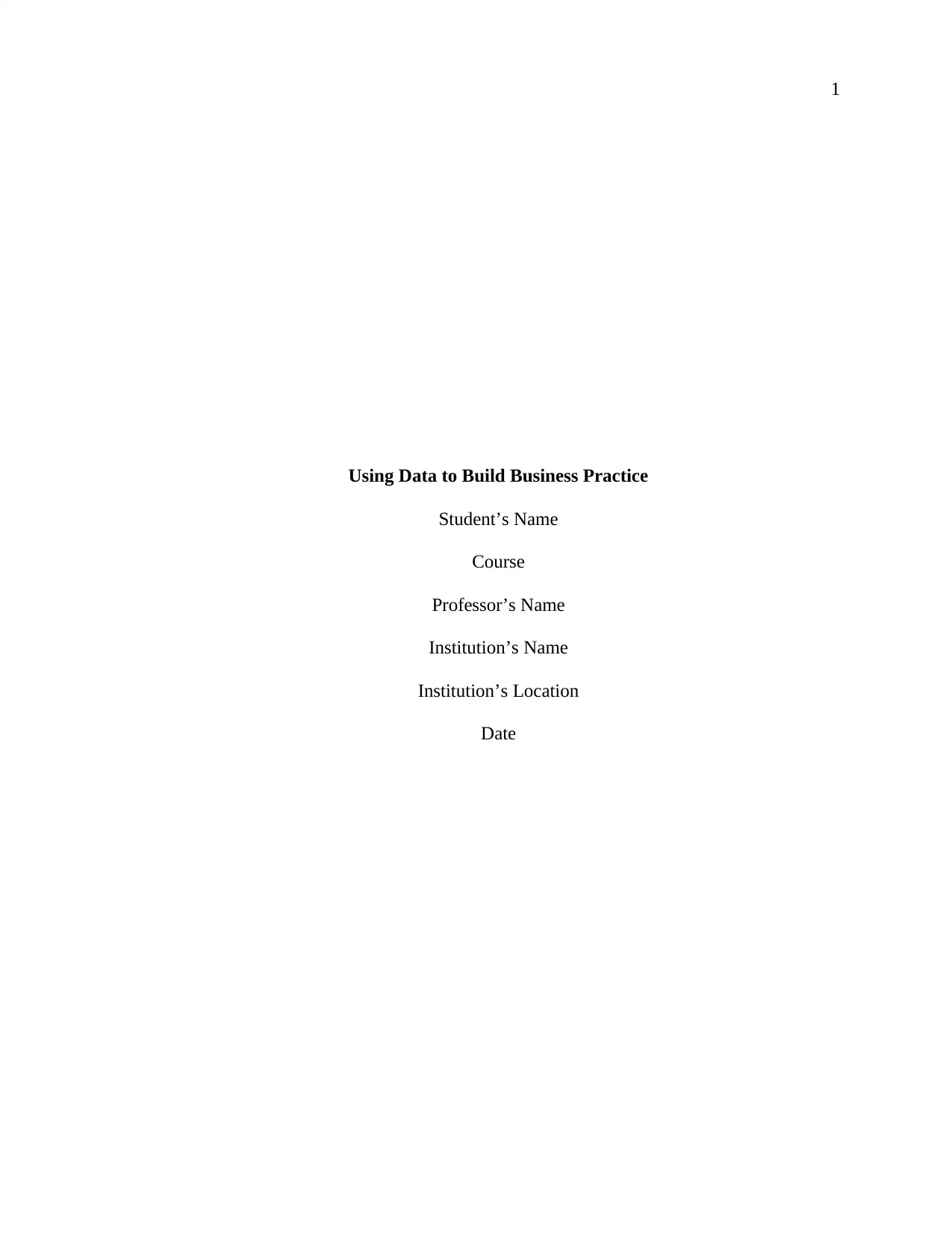
1
Using Data to Build Business Practice
Student’s Name
Course
Professor’s Name
Institution’s Name
Institution’s Location
Date
Using Data to Build Business Practice
Student’s Name
Course
Professor’s Name
Institution’s Name
Institution’s Location
Date
Paraphrase This Document
Need a fresh take? Get an instant paraphrase of this document with our AI Paraphraser
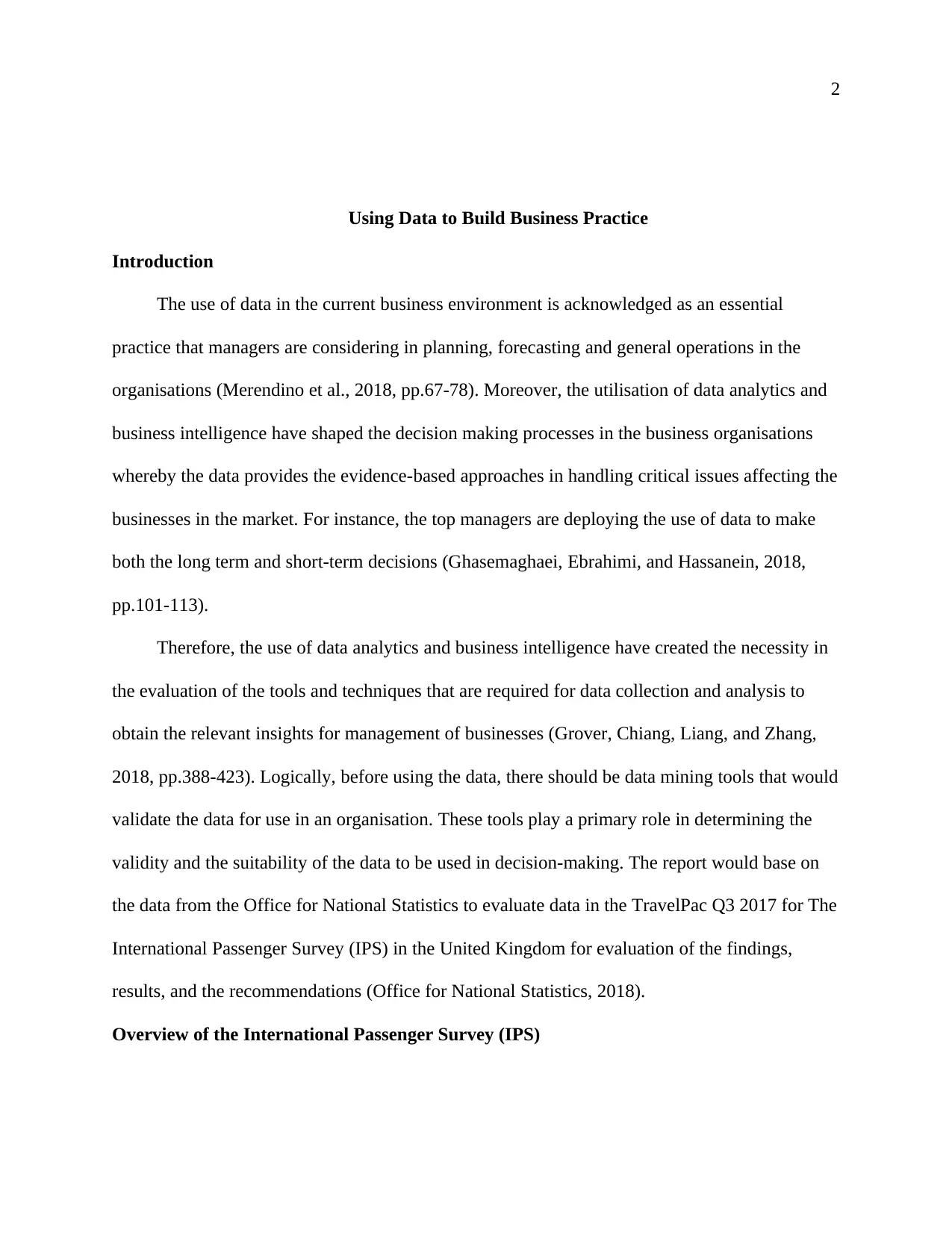
2
Using Data to Build Business Practice
Introduction
The use of data in the current business environment is acknowledged as an essential
practice that managers are considering in planning, forecasting and general operations in the
organisations (Merendino et al., 2018, pp.67-78). Moreover, the utilisation of data analytics and
business intelligence have shaped the decision making processes in the business organisations
whereby the data provides the evidence-based approaches in handling critical issues affecting the
businesses in the market. For instance, the top managers are deploying the use of data to make
both the long term and short-term decisions (Ghasemaghaei, Ebrahimi, and Hassanein, 2018,
pp.101-113).
Therefore, the use of data analytics and business intelligence have created the necessity in
the evaluation of the tools and techniques that are required for data collection and analysis to
obtain the relevant insights for management of businesses (Grover, Chiang, Liang, and Zhang,
2018, pp.388-423). Logically, before using the data, there should be data mining tools that would
validate the data for use in an organisation. These tools play a primary role in determining the
validity and the suitability of the data to be used in decision-making. The report would base on
the data from the Office for National Statistics to evaluate data in the TravelPac Q3 2017 for The
International Passenger Survey (IPS) in the United Kingdom for evaluation of the findings,
results, and the recommendations (Office for National Statistics, 2018).
Overview of the International Passenger Survey (IPS)
Using Data to Build Business Practice
Introduction
The use of data in the current business environment is acknowledged as an essential
practice that managers are considering in planning, forecasting and general operations in the
organisations (Merendino et al., 2018, pp.67-78). Moreover, the utilisation of data analytics and
business intelligence have shaped the decision making processes in the business organisations
whereby the data provides the evidence-based approaches in handling critical issues affecting the
businesses in the market. For instance, the top managers are deploying the use of data to make
both the long term and short-term decisions (Ghasemaghaei, Ebrahimi, and Hassanein, 2018,
pp.101-113).
Therefore, the use of data analytics and business intelligence have created the necessity in
the evaluation of the tools and techniques that are required for data collection and analysis to
obtain the relevant insights for management of businesses (Grover, Chiang, Liang, and Zhang,
2018, pp.388-423). Logically, before using the data, there should be data mining tools that would
validate the data for use in an organisation. These tools play a primary role in determining the
validity and the suitability of the data to be used in decision-making. The report would base on
the data from the Office for National Statistics to evaluate data in the TravelPac Q3 2017 for The
International Passenger Survey (IPS) in the United Kingdom for evaluation of the findings,
results, and the recommendations (Office for National Statistics, 2018).
Overview of the International Passenger Survey (IPS)
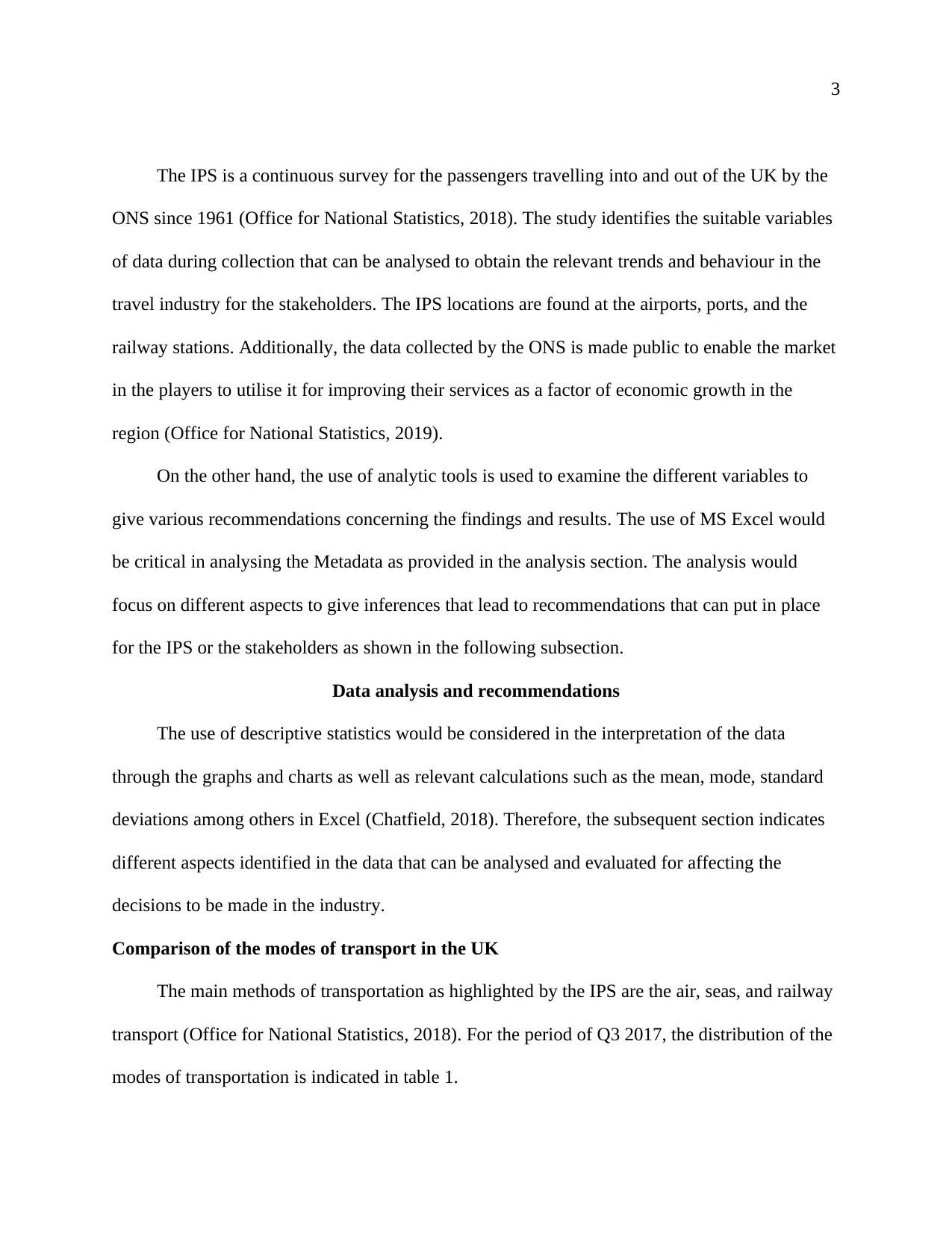
3
The IPS is a continuous survey for the passengers travelling into and out of the UK by the
ONS since 1961 (Office for National Statistics, 2018). The study identifies the suitable variables
of data during collection that can be analysed to obtain the relevant trends and behaviour in the
travel industry for the stakeholders. The IPS locations are found at the airports, ports, and the
railway stations. Additionally, the data collected by the ONS is made public to enable the market
in the players to utilise it for improving their services as a factor of economic growth in the
region (Office for National Statistics, 2019).
On the other hand, the use of analytic tools is used to examine the different variables to
give various recommendations concerning the findings and results. The use of MS Excel would
be critical in analysing the Metadata as provided in the analysis section. The analysis would
focus on different aspects to give inferences that lead to recommendations that can put in place
for the IPS or the stakeholders as shown in the following subsection.
Data analysis and recommendations
The use of descriptive statistics would be considered in the interpretation of the data
through the graphs and charts as well as relevant calculations such as the mean, mode, standard
deviations among others in Excel (Chatfield, 2018). Therefore, the subsequent section indicates
different aspects identified in the data that can be analysed and evaluated for affecting the
decisions to be made in the industry.
Comparison of the modes of transport in the UK
The main methods of transportation as highlighted by the IPS are the air, seas, and railway
transport (Office for National Statistics, 2018). For the period of Q3 2017, the distribution of the
modes of transportation is indicated in table 1.
The IPS is a continuous survey for the passengers travelling into and out of the UK by the
ONS since 1961 (Office for National Statistics, 2018). The study identifies the suitable variables
of data during collection that can be analysed to obtain the relevant trends and behaviour in the
travel industry for the stakeholders. The IPS locations are found at the airports, ports, and the
railway stations. Additionally, the data collected by the ONS is made public to enable the market
in the players to utilise it for improving their services as a factor of economic growth in the
region (Office for National Statistics, 2019).
On the other hand, the use of analytic tools is used to examine the different variables to
give various recommendations concerning the findings and results. The use of MS Excel would
be critical in analysing the Metadata as provided in the analysis section. The analysis would
focus on different aspects to give inferences that lead to recommendations that can put in place
for the IPS or the stakeholders as shown in the following subsection.
Data analysis and recommendations
The use of descriptive statistics would be considered in the interpretation of the data
through the graphs and charts as well as relevant calculations such as the mean, mode, standard
deviations among others in Excel (Chatfield, 2018). Therefore, the subsequent section indicates
different aspects identified in the data that can be analysed and evaluated for affecting the
decisions to be made in the industry.
Comparison of the modes of transport in the UK
The main methods of transportation as highlighted by the IPS are the air, seas, and railway
transport (Office for National Statistics, 2018). For the period of Q3 2017, the distribution of the
modes of transportation is indicated in table 1.
⊘ This is a preview!⊘
Do you want full access?
Subscribe today to unlock all pages.

Trusted by 1+ million students worldwide
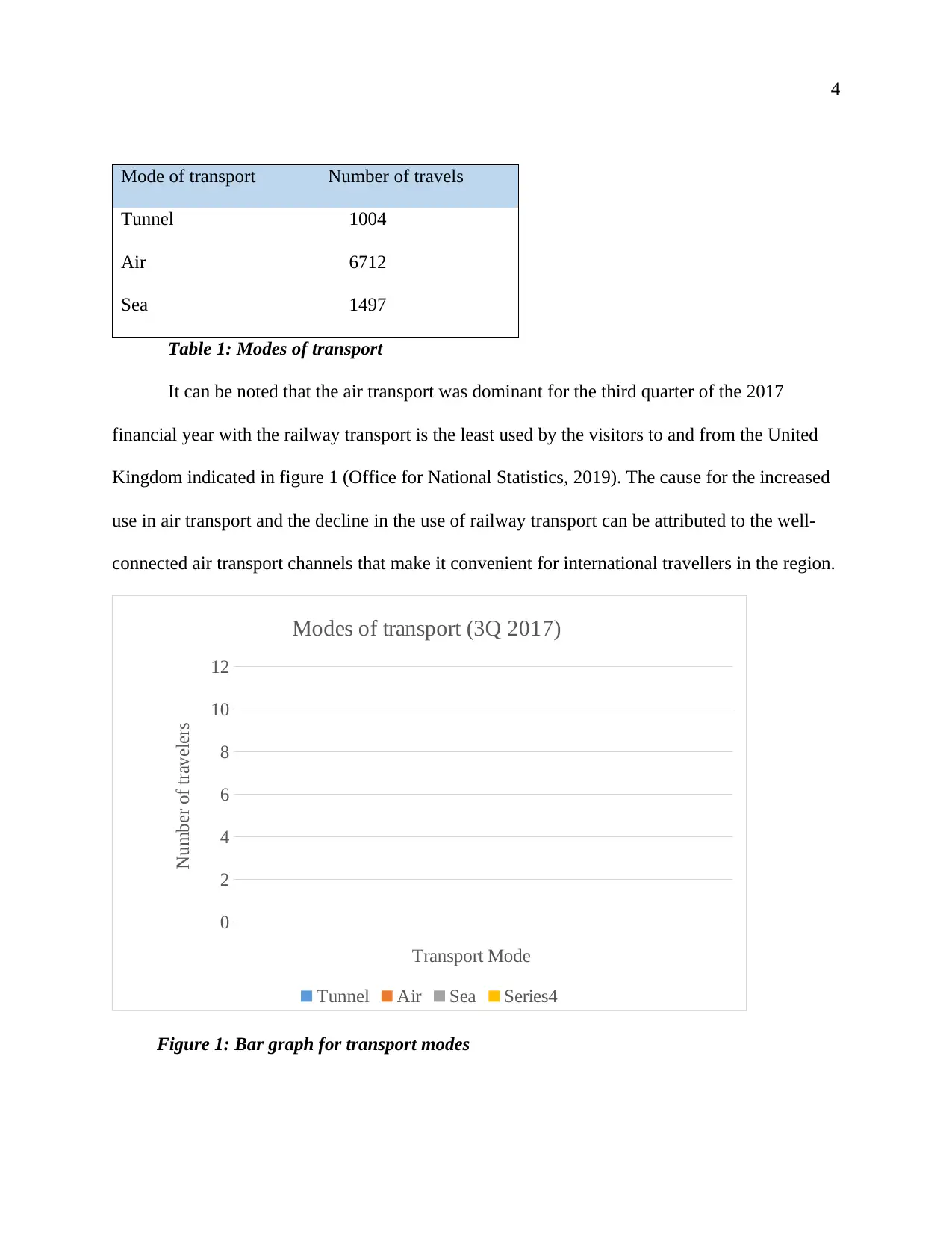
4
Mode of transport Number of travels
Tunnel 1004
Air 6712
Sea 1497
Table 1: Modes of transport
It can be noted that the air transport was dominant for the third quarter of the 2017
financial year with the railway transport is the least used by the visitors to and from the United
Kingdom indicated in figure 1 (Office for National Statistics, 2019). The cause for the increased
use in air transport and the decline in the use of railway transport can be attributed to the well-
connected air transport channels that make it convenient for international travellers in the region.
0
2
4
6
8
10
12
Modes of transport (3Q 2017)
Tunnel Air Sea Series4
Transport Mode
Number of travelers
Figure 1: Bar graph for transport modes
Mode of transport Number of travels
Tunnel 1004
Air 6712
Sea 1497
Table 1: Modes of transport
It can be noted that the air transport was dominant for the third quarter of the 2017
financial year with the railway transport is the least used by the visitors to and from the United
Kingdom indicated in figure 1 (Office for National Statistics, 2019). The cause for the increased
use in air transport and the decline in the use of railway transport can be attributed to the well-
connected air transport channels that make it convenient for international travellers in the region.
0
2
4
6
8
10
12
Modes of transport (3Q 2017)
Tunnel Air Sea Series4
Transport Mode
Number of travelers
Figure 1: Bar graph for transport modes
Paraphrase This Document
Need a fresh take? Get an instant paraphrase of this document with our AI Paraphraser
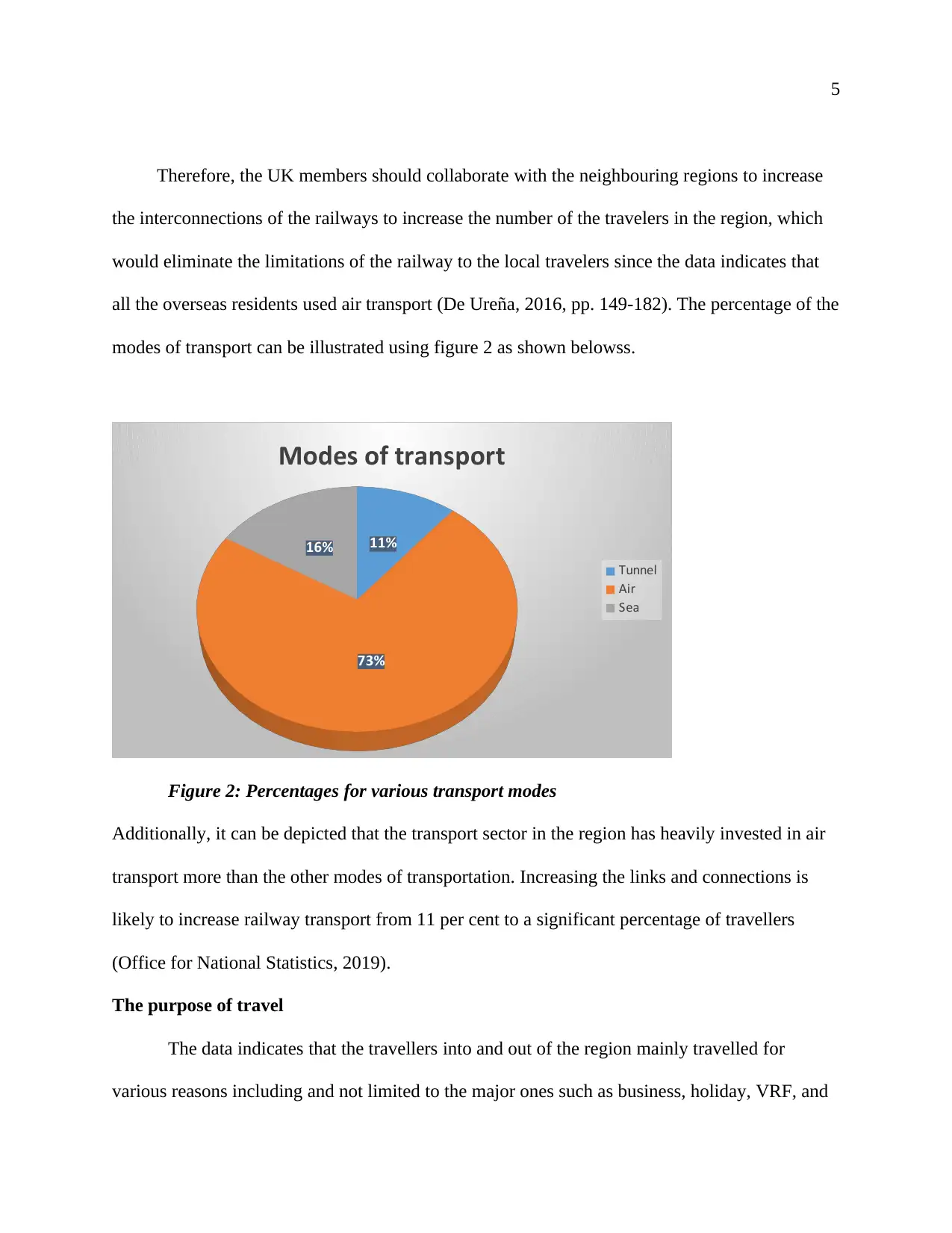
5
Therefore, the UK members should collaborate with the neighbouring regions to increase
the interconnections of the railways to increase the number of the travelers in the region, which
would eliminate the limitations of the railway to the local travelers since the data indicates that
all the overseas residents used air transport (De Ureña, 2016, pp. 149-182). The percentage of the
modes of transport can be illustrated using figure 2 as shown belowss.
11%
73%
16%
Modes of transport
Tunnel
Air
Sea
Figure 2: Percentages for various transport modes
Additionally, it can be depicted that the transport sector in the region has heavily invested in air
transport more than the other modes of transportation. Increasing the links and connections is
likely to increase railway transport from 11 per cent to a significant percentage of travellers
(Office for National Statistics, 2019).
The purpose of travel
The data indicates that the travellers into and out of the region mainly travelled for
various reasons including and not limited to the major ones such as business, holiday, VRF, and
Therefore, the UK members should collaborate with the neighbouring regions to increase
the interconnections of the railways to increase the number of the travelers in the region, which
would eliminate the limitations of the railway to the local travelers since the data indicates that
all the overseas residents used air transport (De Ureña, 2016, pp. 149-182). The percentage of the
modes of transport can be illustrated using figure 2 as shown belowss.
11%
73%
16%
Modes of transport
Tunnel
Air
Sea
Figure 2: Percentages for various transport modes
Additionally, it can be depicted that the transport sector in the region has heavily invested in air
transport more than the other modes of transportation. Increasing the links and connections is
likely to increase railway transport from 11 per cent to a significant percentage of travellers
(Office for National Statistics, 2019).
The purpose of travel
The data indicates that the travellers into and out of the region mainly travelled for
various reasons including and not limited to the major ones such as business, holiday, VRF, and
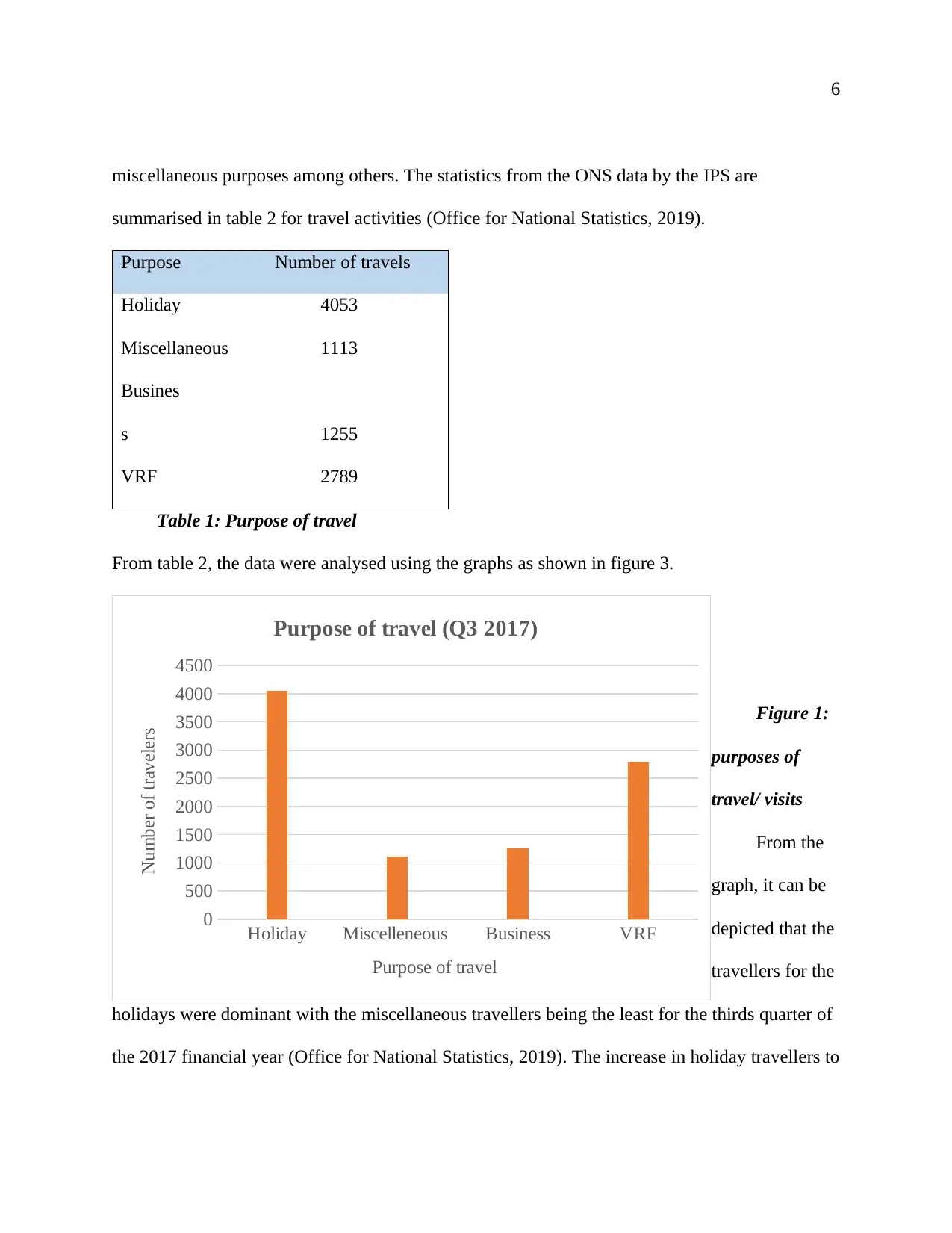
6
miscellaneous purposes among others. The statistics from the ONS data by the IPS are
summarised in table 2 for travel activities (Office for National Statistics, 2019).
Purpose Number of travels
Holiday 4053
Miscellaneous 1113
Busines
s 1255
VRF 2789
Table 1: Purpose of travel
From table 2, the data were analysed using the graphs as shown in figure 3.
Figure 1:
purposes of
travel/ visits
From the
graph, it can be
depicted that the
travellers for the
holidays were dominant with the miscellaneous travellers being the least for the thirds quarter of
the 2017 financial year (Office for National Statistics, 2019). The increase in holiday travellers to
Holiday Miscelleneous Business VRF
0
500
1000
1500
2000
2500
3000
3500
4000
4500
Purpose of travel (Q3 2017)
Purpose of travel
Number of travelers
miscellaneous purposes among others. The statistics from the ONS data by the IPS are
summarised in table 2 for travel activities (Office for National Statistics, 2019).
Purpose Number of travels
Holiday 4053
Miscellaneous 1113
Busines
s 1255
VRF 2789
Table 1: Purpose of travel
From table 2, the data were analysed using the graphs as shown in figure 3.
Figure 1:
purposes of
travel/ visits
From the
graph, it can be
depicted that the
travellers for the
holidays were dominant with the miscellaneous travellers being the least for the thirds quarter of
the 2017 financial year (Office for National Statistics, 2019). The increase in holiday travellers to
Holiday Miscelleneous Business VRF
0
500
1000
1500
2000
2500
3000
3500
4000
4500
Purpose of travel (Q3 2017)
Purpose of travel
Number of travelers
⊘ This is a preview!⊘
Do you want full access?
Subscribe today to unlock all pages.

Trusted by 1+ million students worldwide
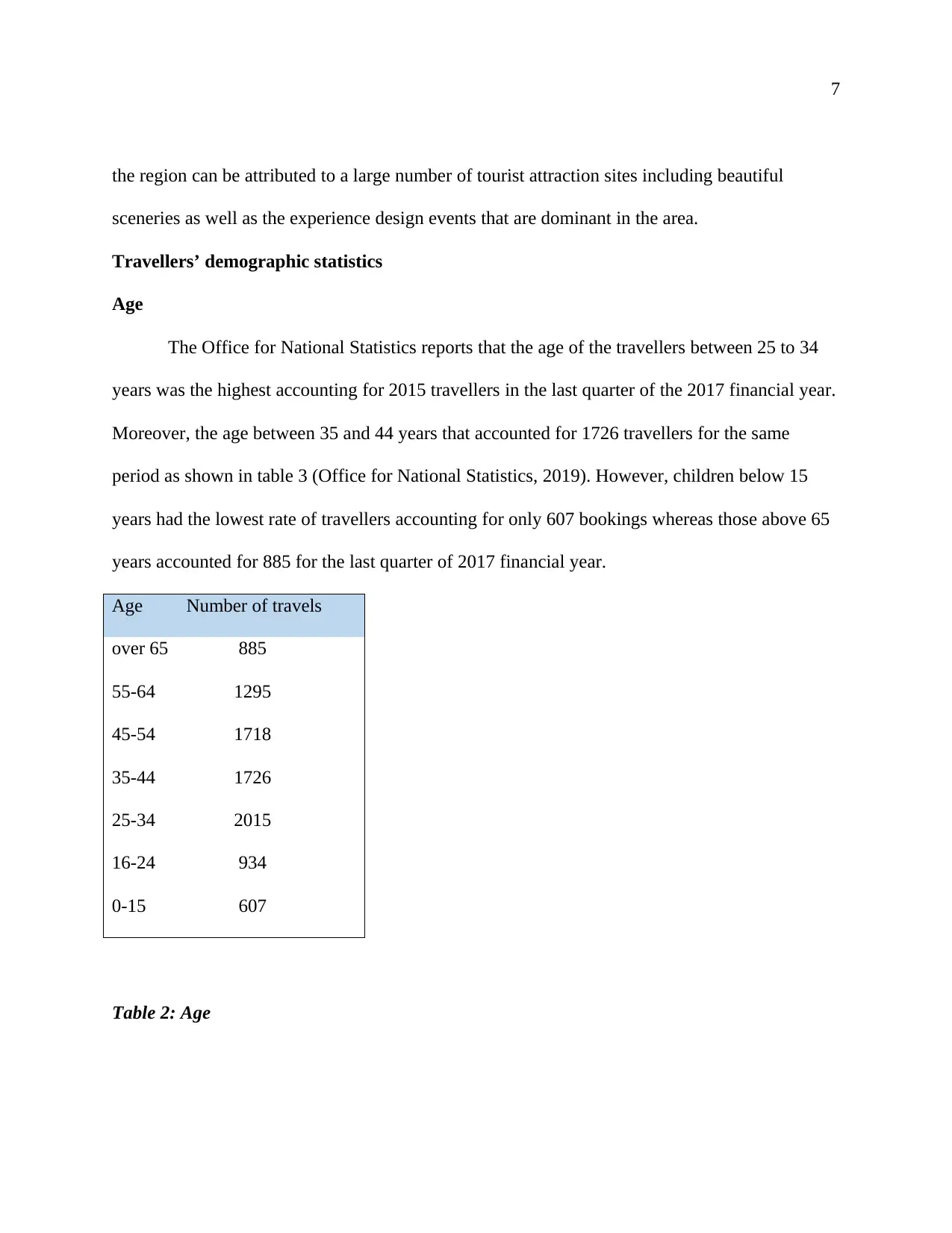
7
the region can be attributed to a large number of tourist attraction sites including beautiful
sceneries as well as the experience design events that are dominant in the area.
Travellers’ demographic statistics
Age
The Office for National Statistics reports that the age of the travellers between 25 to 34
years was the highest accounting for 2015 travellers in the last quarter of the 2017 financial year.
Moreover, the age between 35 and 44 years that accounted for 1726 travellers for the same
period as shown in table 3 (Office for National Statistics, 2019). However, children below 15
years had the lowest rate of travellers accounting for only 607 bookings whereas those above 65
years accounted for 885 for the last quarter of 2017 financial year.
Table 2: Age
Age Number of travels
over 65 885
55-64 1295
45-54 1718
35-44 1726
25-34 2015
16-24 934
0-15 607
the region can be attributed to a large number of tourist attraction sites including beautiful
sceneries as well as the experience design events that are dominant in the area.
Travellers’ demographic statistics
Age
The Office for National Statistics reports that the age of the travellers between 25 to 34
years was the highest accounting for 2015 travellers in the last quarter of the 2017 financial year.
Moreover, the age between 35 and 44 years that accounted for 1726 travellers for the same
period as shown in table 3 (Office for National Statistics, 2019). However, children below 15
years had the lowest rate of travellers accounting for only 607 bookings whereas those above 65
years accounted for 885 for the last quarter of 2017 financial year.
Table 2: Age
Age Number of travels
over 65 885
55-64 1295
45-54 1718
35-44 1726
25-34 2015
16-24 934
0-15 607
Paraphrase This Document
Need a fresh take? Get an instant paraphrase of this document with our AI Paraphraser
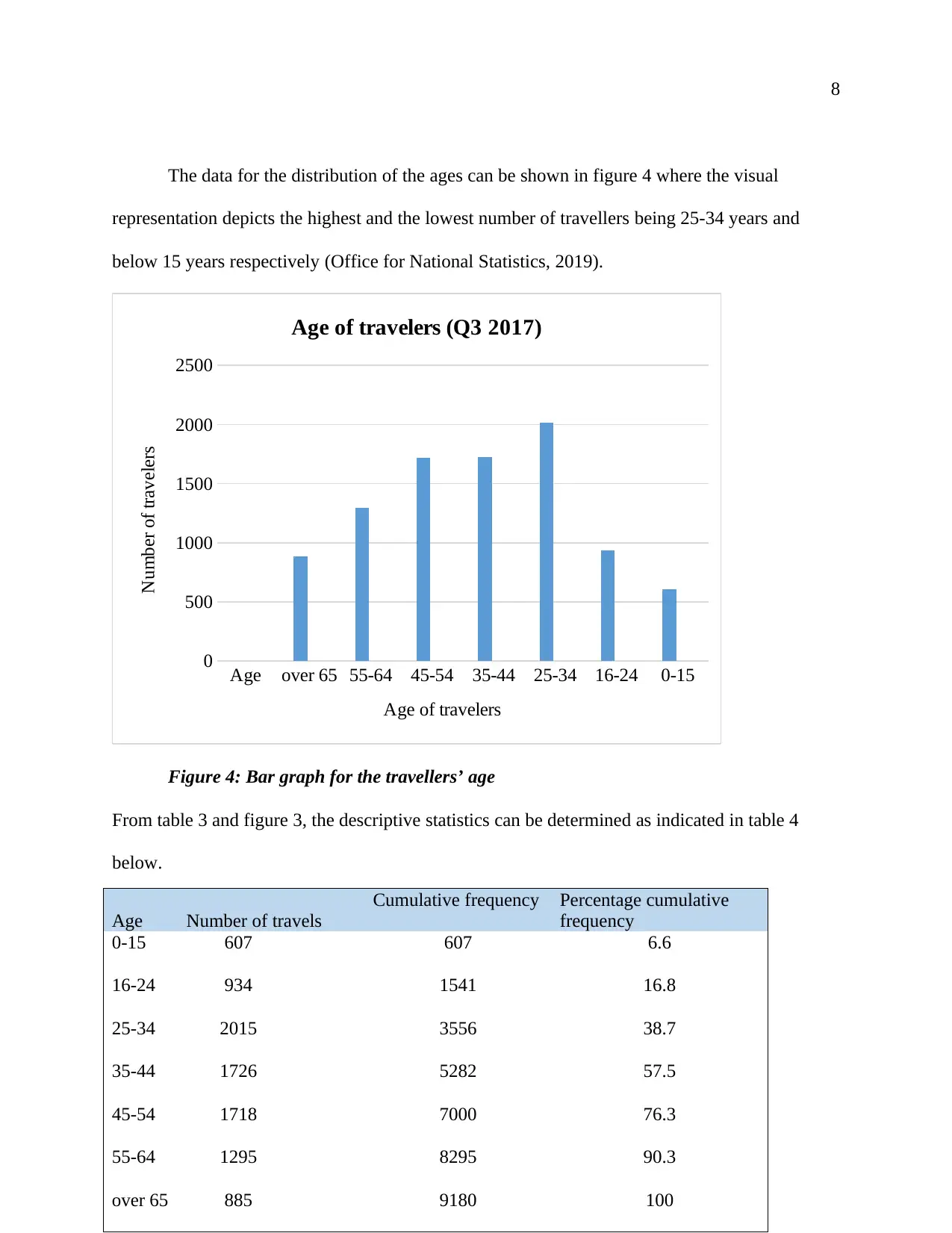
8
The data for the distribution of the ages can be shown in figure 4 where the visual
representation depicts the highest and the lowest number of travellers being 25-34 years and
below 15 years respectively (Office for National Statistics, 2019).
Age over 65 55-64 45-54 35-44 25-34 16-24 0-15
0
500
1000
1500
2000
2500
Age of travelers (Q3 2017)
Age of travelers
Number of travelers
Figure 4: Bar graph for the travellers’ age
From table 3 and figure 3, the descriptive statistics can be determined as indicated in table 4
below.
Age Number of travels
Cumulative frequency Percentage cumulative
frequency
0-15 607 607 6.6
16-24 934 1541 16.8
25-34 2015 3556 38.7
35-44 1726 5282 57.5
45-54 1718 7000 76.3
55-64 1295 8295 90.3
over 65 885 9180 100
The data for the distribution of the ages can be shown in figure 4 where the visual
representation depicts the highest and the lowest number of travellers being 25-34 years and
below 15 years respectively (Office for National Statistics, 2019).
Age over 65 55-64 45-54 35-44 25-34 16-24 0-15
0
500
1000
1500
2000
2500
Age of travelers (Q3 2017)
Age of travelers
Number of travelers
Figure 4: Bar graph for the travellers’ age
From table 3 and figure 3, the descriptive statistics can be determined as indicated in table 4
below.
Age Number of travels
Cumulative frequency Percentage cumulative
frequency
0-15 607 607 6.6
16-24 934 1541 16.8
25-34 2015 3556 38.7
35-44 1726 5282 57.5
45-54 1718 7000 76.3
55-64 1295 8295 90.3
over 65 885 9180 100
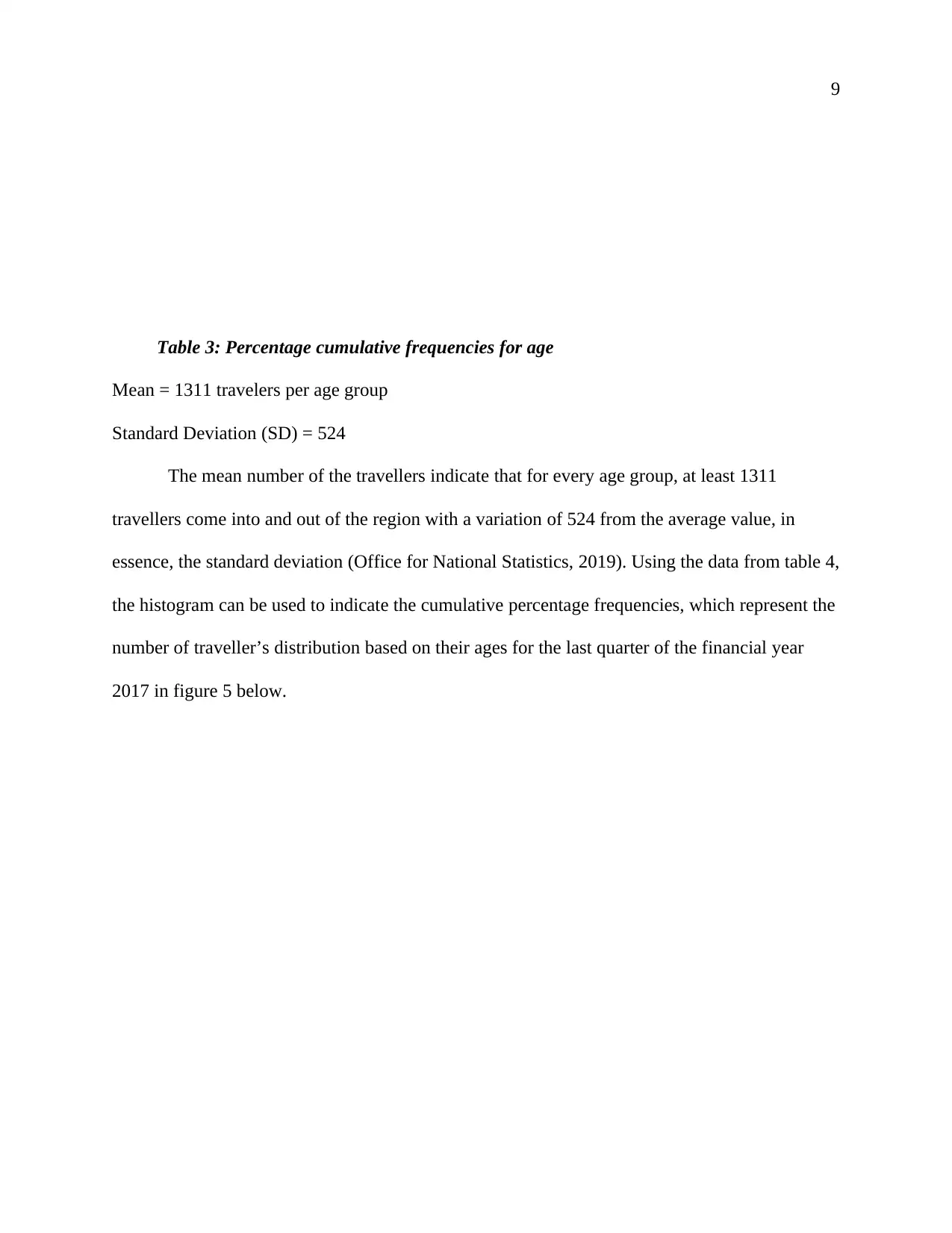
9
Table 3: Percentage cumulative frequencies for age
Mean = 1311 travelers per age group
Standard Deviation (SD) = 524
The mean number of the travellers indicate that for every age group, at least 1311
travellers come into and out of the region with a variation of 524 from the average value, in
essence, the standard deviation (Office for National Statistics, 2019). Using the data from table 4,
the histogram can be used to indicate the cumulative percentage frequencies, which represent the
number of traveller’s distribution based on their ages for the last quarter of the financial year
2017 in figure 5 below.
Table 3: Percentage cumulative frequencies for age
Mean = 1311 travelers per age group
Standard Deviation (SD) = 524
The mean number of the travellers indicate that for every age group, at least 1311
travellers come into and out of the region with a variation of 524 from the average value, in
essence, the standard deviation (Office for National Statistics, 2019). Using the data from table 4,
the histogram can be used to indicate the cumulative percentage frequencies, which represent the
number of traveller’s distribution based on their ages for the last quarter of the financial year
2017 in figure 5 below.
⊘ This is a preview!⊘
Do you want full access?
Subscribe today to unlock all pages.

Trusted by 1+ million students worldwide
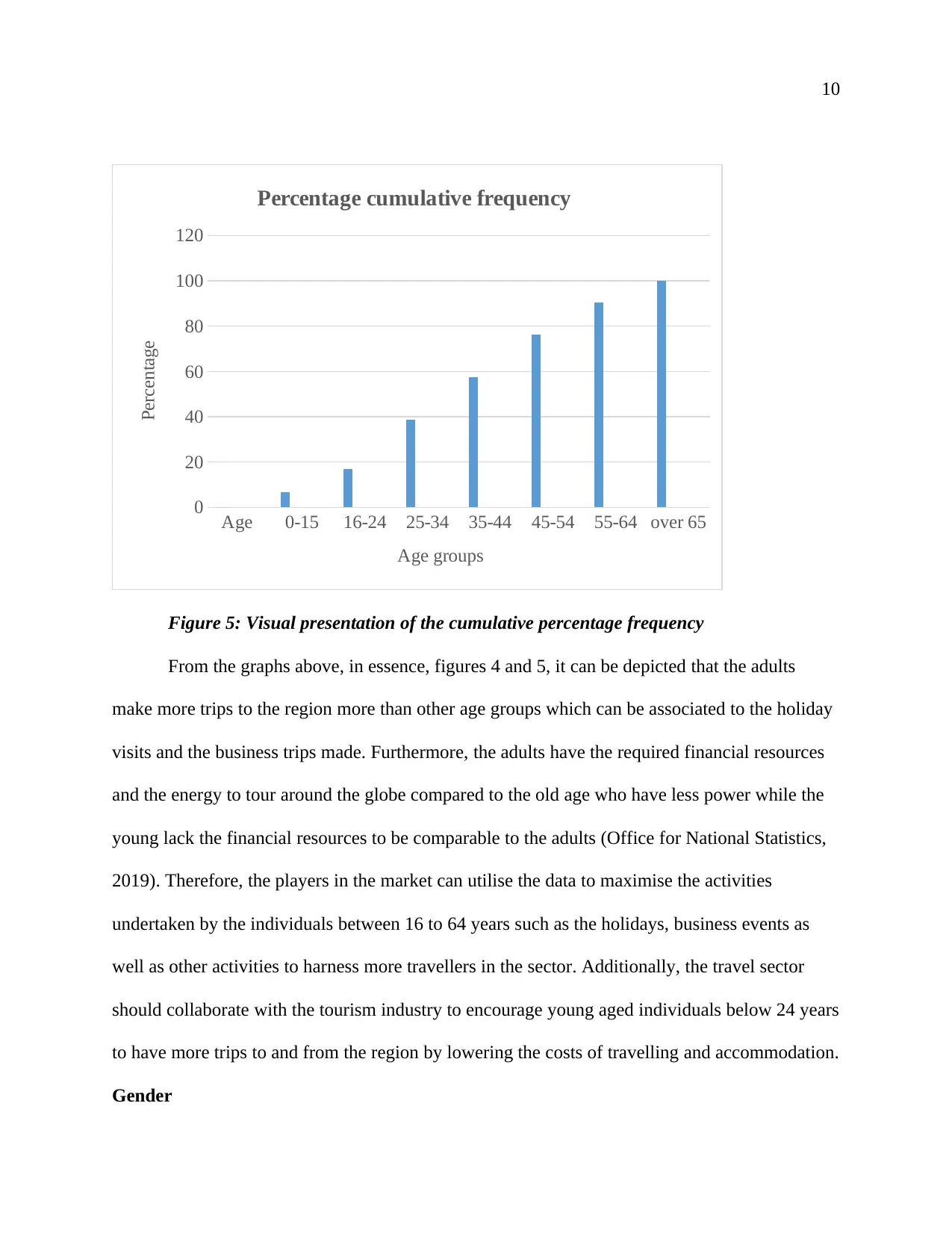
10
Age 0-15 16-24 25-34 35-44 45-54 55-64 over 65
0
20
40
60
80
100
120
Percentage cumulative frequency
Age groups
Percentage
Figure 5: Visual presentation of the cumulative percentage frequency
From the graphs above, in essence, figures 4 and 5, it can be depicted that the adults
make more trips to the region more than other age groups which can be associated to the holiday
visits and the business trips made. Furthermore, the adults have the required financial resources
and the energy to tour around the globe compared to the old age who have less power while the
young lack the financial resources to be comparable to the adults (Office for National Statistics,
2019). Therefore, the players in the market can utilise the data to maximise the activities
undertaken by the individuals between 16 to 64 years such as the holidays, business events as
well as other activities to harness more travellers in the sector. Additionally, the travel sector
should collaborate with the tourism industry to encourage young aged individuals below 24 years
to have more trips to and from the region by lowering the costs of travelling and accommodation.
Gender
Age 0-15 16-24 25-34 35-44 45-54 55-64 over 65
0
20
40
60
80
100
120
Percentage cumulative frequency
Age groups
Percentage
Figure 5: Visual presentation of the cumulative percentage frequency
From the graphs above, in essence, figures 4 and 5, it can be depicted that the adults
make more trips to the region more than other age groups which can be associated to the holiday
visits and the business trips made. Furthermore, the adults have the required financial resources
and the energy to tour around the globe compared to the old age who have less power while the
young lack the financial resources to be comparable to the adults (Office for National Statistics,
2019). Therefore, the players in the market can utilise the data to maximise the activities
undertaken by the individuals between 16 to 64 years such as the holidays, business events as
well as other activities to harness more travellers in the sector. Additionally, the travel sector
should collaborate with the tourism industry to encourage young aged individuals below 24 years
to have more trips to and from the region by lowering the costs of travelling and accommodation.
Gender
Paraphrase This Document
Need a fresh take? Get an instant paraphrase of this document with our AI Paraphraser
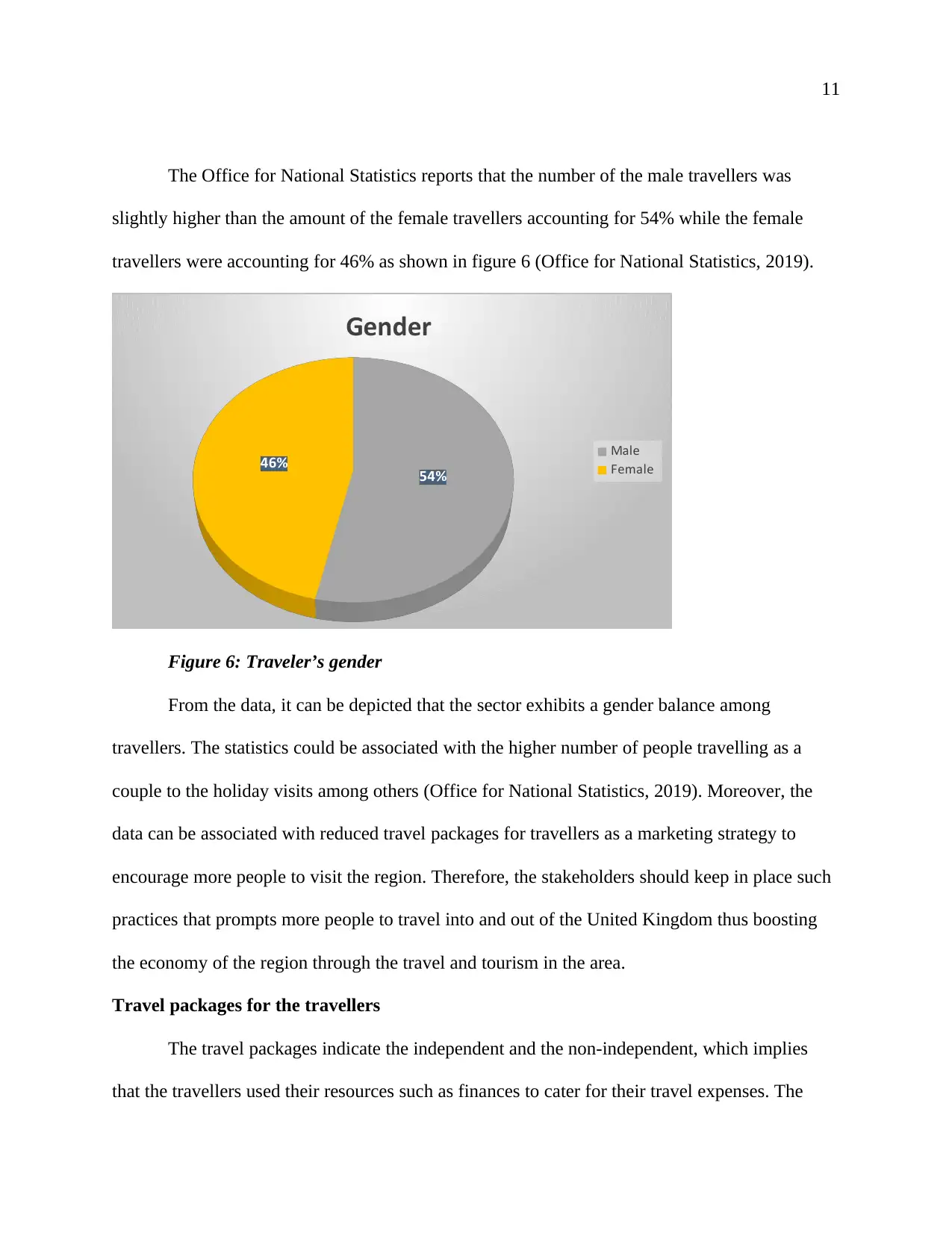
11
The Office for National Statistics reports that the number of the male travellers was
slightly higher than the amount of the female travellers accounting for 54% while the female
travellers were accounting for 46% as shown in figure 6 (Office for National Statistics, 2019).
54%
46%
Gender
Male
Female
Figure 6: Traveler’s gender
From the data, it can be depicted that the sector exhibits a gender balance among
travellers. The statistics could be associated with the higher number of people travelling as a
couple to the holiday visits among others (Office for National Statistics, 2019). Moreover, the
data can be associated with reduced travel packages for travellers as a marketing strategy to
encourage more people to visit the region. Therefore, the stakeholders should keep in place such
practices that prompts more people to travel into and out of the United Kingdom thus boosting
the economy of the region through the travel and tourism in the area.
Travel packages for the travellers
The travel packages indicate the independent and the non-independent, which implies
that the travellers used their resources such as finances to cater for their travel expenses. The
The Office for National Statistics reports that the number of the male travellers was
slightly higher than the amount of the female travellers accounting for 54% while the female
travellers were accounting for 46% as shown in figure 6 (Office for National Statistics, 2019).
54%
46%
Gender
Male
Female
Figure 6: Traveler’s gender
From the data, it can be depicted that the sector exhibits a gender balance among
travellers. The statistics could be associated with the higher number of people travelling as a
couple to the holiday visits among others (Office for National Statistics, 2019). Moreover, the
data can be associated with reduced travel packages for travellers as a marketing strategy to
encourage more people to visit the region. Therefore, the stakeholders should keep in place such
practices that prompts more people to travel into and out of the United Kingdom thus boosting
the economy of the region through the travel and tourism in the area.
Travel packages for the travellers
The travel packages indicate the independent and the non-independent, which implies
that the travellers used their resources such as finances to cater for their travel expenses. The
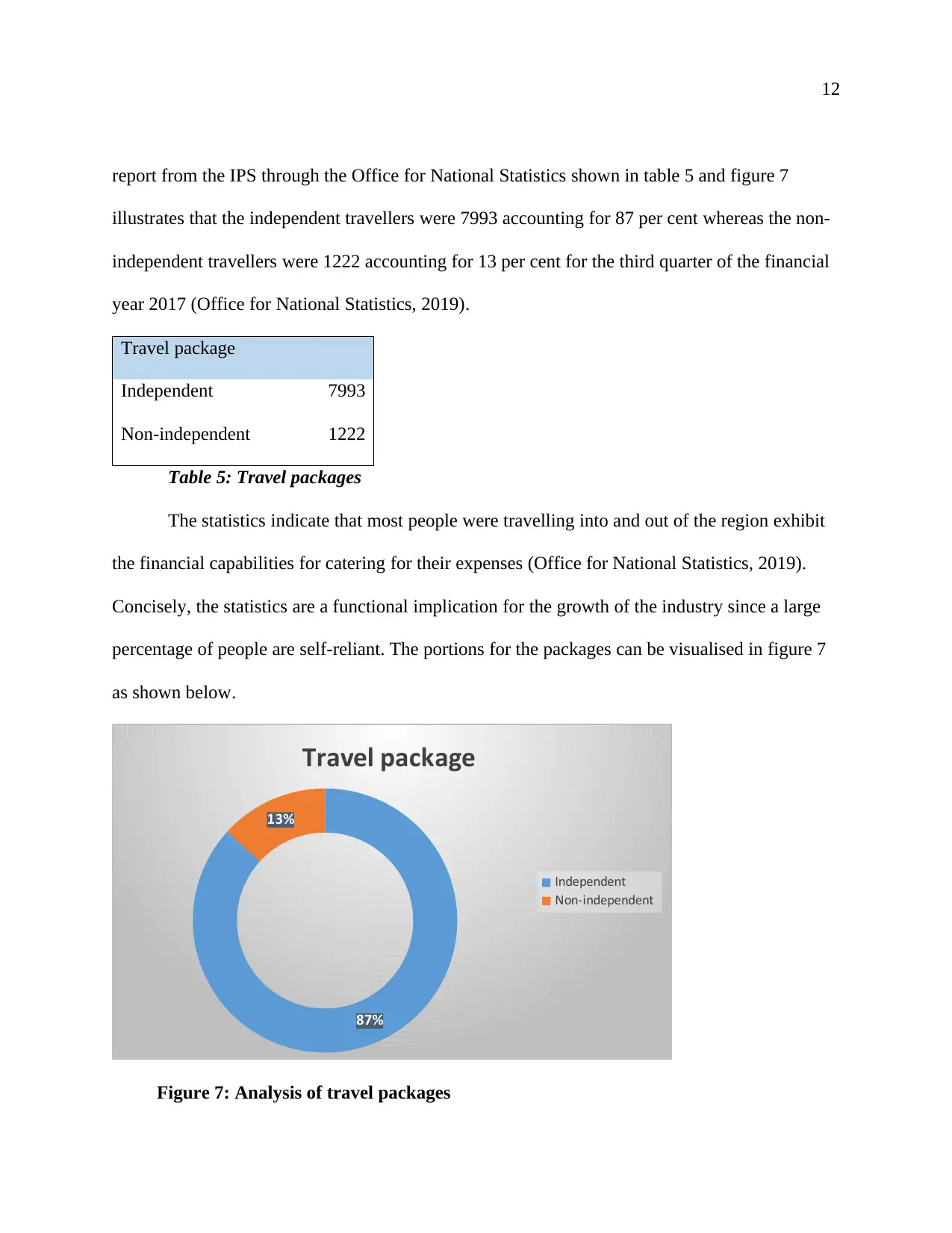
12
report from the IPS through the Office for National Statistics shown in table 5 and figure 7
illustrates that the independent travellers were 7993 accounting for 87 per cent whereas the non-
independent travellers were 1222 accounting for 13 per cent for the third quarter of the financial
year 2017 (Office for National Statistics, 2019).
Travel package
Independent 7993
Non-independent 1222
Table 5: Travel packages
The statistics indicate that most people were travelling into and out of the region exhibit
the financial capabilities for catering for their expenses (Office for National Statistics, 2019).
Concisely, the statistics are a functional implication for the growth of the industry since a large
percentage of people are self-reliant. The portions for the packages can be visualised in figure 7
as shown below.
87%
13%
Travel package
Independent
Non-independent
Figure 7: Analysis of travel packages
report from the IPS through the Office for National Statistics shown in table 5 and figure 7
illustrates that the independent travellers were 7993 accounting for 87 per cent whereas the non-
independent travellers were 1222 accounting for 13 per cent for the third quarter of the financial
year 2017 (Office for National Statistics, 2019).
Travel package
Independent 7993
Non-independent 1222
Table 5: Travel packages
The statistics indicate that most people were travelling into and out of the region exhibit
the financial capabilities for catering for their expenses (Office for National Statistics, 2019).
Concisely, the statistics are a functional implication for the growth of the industry since a large
percentage of people are self-reliant. The portions for the packages can be visualised in figure 7
as shown below.
87%
13%
Travel package
Independent
Non-independent
Figure 7: Analysis of travel packages
⊘ This is a preview!⊘
Do you want full access?
Subscribe today to unlock all pages.

Trusted by 1+ million students worldwide
1 out of 19
Related Documents
Your All-in-One AI-Powered Toolkit for Academic Success.
+13062052269
info@desklib.com
Available 24*7 on WhatsApp / Email
![[object Object]](/_next/static/media/star-bottom.7253800d.svg)
Unlock your academic potential
Copyright © 2020–2025 A2Z Services. All Rights Reserved. Developed and managed by ZUCOL.




